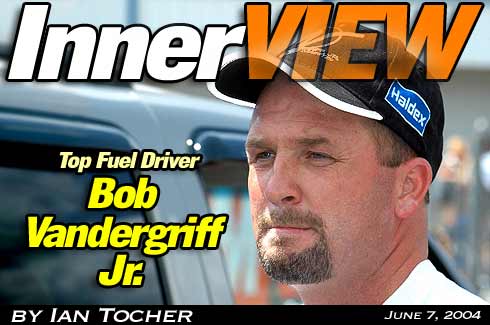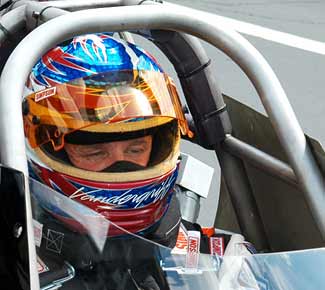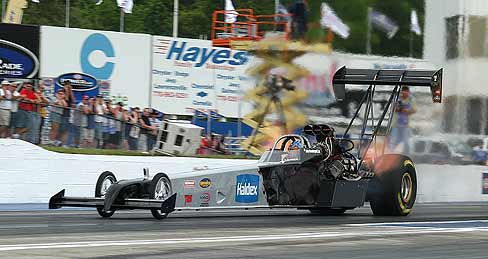
![]() fter
earning NHRA Rookie of the Year honors in 1994, Bob Vandergriff Jr. appeared
in six Top Fuel final rounds—including the 1995 U.S. Nationals—before
leaving the sport at the end of the 2000 season. He made a return to competition
at the Atlanta event this year, however, with crew chief Rob Flynn (formerly
of Cruz Pedregon’s and Del Worsham’s Funny Car teams), handling the
tune-up on Vandergriff’s Haldex-backed dragster.
fter
earning NHRA Rookie of the Year honors in 1994, Bob Vandergriff Jr. appeared
in six Top Fuel final rounds—including the 1995 U.S. Nationals—before
leaving the sport at the end of the 2000 season. He made a return to competition
at the Atlanta event this year, however, with crew chief Rob Flynn (formerly
of Cruz Pedregon’s and Del Worsham’s Funny Car teams), handling the
tune-up on Vandergriff’s Haldex-backed dragster.
Vandergriff has qualified at three races since his comeback, but bowed out in Atlanta in the opening round, had a similar exit at Chicago, and finally got his first round win at Topeka. While still in Atlanta, the Alpharetta, Ga.-based driver spoke with DRO about sponsorship issues and ways to increase drag racing’s fan appeal.
DRO: What made you quit Top Fuel after the 2000 season?
Vandergriff: Well, one reason I stopped is we lost our sponsor, obviously, and we got kind of late notice on it so our hands were kind of tied on putting together a new deal. And then it was the same time we started our family. It was hard to be gone with one child, but when the second one arrived, the prospect of being gone 30 weeks a year wasn’t very appealing. I didn’t get married and have a family to say, ‘See you in three weeks or a month,’ and traveling with them, we tried that, but between baby strollers and cribs, and baby bags and staying out at the track late and screwing up their schedules, it just didn’t work. So, I decided at that time I’d just stay home for at least a couple of years until they were old enough to travel and we didn’t have to deal with strollers and all that stuff. They’re five and three now and we bought a nice motor coach, so it’s a lot easier now.
DRO: So you always planned to return?
Vandergriff: Yeah, we had kind of targeted 2005, but then a good friend of mine, Rob Flynn, became available. It actually hatched during the rainout in Pomona this year, sitting around in the pouring rain with no racecar, no trailer, nowhere to stand except under other people’s awnings and we looked at each other and said, ‘Man, we need to have a racecar.’
So we actually were at my brother Kevin’s house for dinner and started talking, saying, ‘We oughta’ run Atlanta. It’s right in our backyard and we’ve got all these parts and pieces and it wouldn’t cost that much.’ Then we said, ’Well, if we’re gonna’ run Atlanta, why don’t we try to run a few more races,’ and then it grew to 10 races and we said, ’Now we’ve gotta’ go raise some money,’ and we started knocking on some doors to people who have helped me throughout my career and the next thing you know we had enough to run 10 races.
Since Rob was available—Rob or Johnny West, those are the two guys I’d like to work with—it kind of speeded up our plan and we’re going to try to turn this into something for next year.
 DRO:
Why was getting Rob so important to you?
DRO:
Why was getting Rob so important to you?
Vandergriff: I think he’s one of the best and probably one of the most underrated crew chiefs out here, as far as the younger guys go. Some of the places he’s been, I think he’s been given a bad rap and I don’t think he’s really been given the opportunity to show what he’s capable of. He’s either been in somebody’s mess or cleaning up somebody’s mess. Unfortunately for him, he’s not a guy that just goes in with the quick fix. He picks at stuff and works at stuff and I think if he’d been given an ample amount of time to chart a direction and go there, he’d already have been very successful.
I’m actually pretty happy that other teams made bad decisions because it made him available to us. We’re going to show everyone just how bad their decisions were.
DRO: Which races are you going to hit this year?
Vandergriff: We’re going to run Atlanta, Chicago, Topeka; and then we’ll run Columbus, Englishtown, and St. Louis; and if we can get a little more funding it will allow us to go on the West Coast swing. If we do not go on the West Coast swing, then we’ll come back for Brainerd, Memphis, Indy, and Reading. If we haven’t secured any more funding by then, we’ll be done for this year.
DRO: What’s the realistic cost for you to go racing?
Vandergriff: Well, we had everything, but we did have to freshen some stuff up, buy some new heads and new blocks and other parts and pieces. So, other than that, by the time you pay the crew guys and the insurance and the hotels and costs at the track, you’re looking at about $50 grand per race on the downside. Now, if you want to go out and knock heads with some of them other teams, it could cost you $100 grand, or more. And that’s obviously what we’re looking for in the long term.
DRO: You’ve got Haldex on the side of the car now. What do they do?
Vandergriff: Haldex makes brake adjusters for 18 wheelers. They’re the leader in that category, a big company, and a great supporter of mine. Chuck Kleinhagen, he’s the company president and a family friend for many years, and when I called him, he said, ‘No problem.’ They’re based in Kansas City and without their support we wouldn’t be here.
DRO: Why race a partial season with NHRA when you could go over and run an 11-race season in IHRA and probably give Clay Millican a good run for the championship?
Vandergriff: Basically it’s because you’re looking at the cream of the crop over here. It’s like the major leagues versus double-A or whatever. You can take a look over there and see there’s no names of any magnitude on the cars, other than Millican’s team. If you want to knock heads with the best—and that’s why we’re out here—this is where you have to be.
Part of it’s competitive, but it’s also the opportunity NHRA provides to help us in attracting a multi-million-dollar sponsor. It’s an easier sell to ask for that kind of money over here compared to over there.

DRO: How much money do you need to race a full season?
Vandergriff: It really depends on the sponsor’s goals with the race team, but two-million dollars will make you very competitive out here. I mean, we finished in the top 10 every year spending about that amount. Now, if you want to test every Monday after every race, and you want to have some R&D programs, and you want to hire the best people, and people to manage other people, and take that and consume every moment trying to win a championship, it can easily cost over three-million dollars. It just depends on what the goals are. My previous sponsor was more concerned with the products we sold for them; as long as we had a competitive team, that suited them just fine.
DRO: What are the benefits of drag racing to a sponsor, specifically a non-tool, non-beer or tobacco, non-automotive parts company?
Vandergriff: I think drag racing is a great fit for companies that actually need interaction with the spectators. If you’re just looking for mass television numbers, then obviously NASCAR is a great fit for that, but if you actually need to be able to interact with spectators and show them your product, show them how it works, or show them why it’s better than your competitor’s, then drag racing is the best fit.
DRO: Would you also say an NHRA team sponsorship is more cost effective than a NASCAR deal?
Vandergriff: There’s very much a better dollar-to-return ratio over here than in 99 percent of the programs in NASCAR. You can go over there and spend 10 or 15 million dollars and it’s not going to guarantee you anything, but you can come here and spend two or three million and be one of the heroes, and get your marketing message across to basically the same demographics, the same do-it-yourself-type guys—actually, even more so in drag racing fans. It’s a very cost-effective way to reach the same customers and I wish more companies weren’t so enamored with if they’re gonna’ be in racing, it’s gotta’ be in NASCAR. I think if they just looked at us for dollar per return, you’d see more companies coming this way.
DRO: Did you have a deal in the works with Coca-Cola or POWERade before POWERade signed on as NHRA’s title sponsor?
Vandergriff: Well, we’d actually been educating POWERade on drag racing and the opportunity, and obviously they were very interested in our sport.
DRO: What time frame was that?
Vandergriff: Shortly before they became sponsor of the NHRA drag racing series. I think when Winston pulled out of the sport it provided POWERade an opportunity that fit more with their corporate marketing plan. NHRA had actually gone to Coca-Cola and Coke passed on the opportunity, but made the point that POWERade had been taking a look at drag racing. So the opportunity to sponsor the series was made to POWERade.
DRO: Was that upsetting to you at the time?
Vandergriff: No, because it’s hard to say what POWERade would have done, but I definitely think we piqued their interest in the sport.
DRO: What can NHRA do to make drag racing a bigger sport?
Vandergriff: Some of the things I’ve learned in the last three years just sitting in the bleachers and listening to the fans are what they want to see on the track, and what’s missing, and the personalities of our sport, and what we need to do to make our sport a bigger entity. I think the best thing we’ve had over the last two years has been the Force-Bazemore rivalry. Every time that heats up, NHRA does their best to put it out and I don’t understand that. If I was them, I’d even encourage it because it’s something that transcends the actual race and makes people want to watch a particular run more than another one. When Force races Bazemore, whether you like John or you like Whit, there’s a reason to watch outside of just two cars going down the track. There are personalities involved and if you think something’s gonna’ happen, you’re gonna’ want to watch it.
Now, if John Force, he may be John Force, but if he had berated my crew chief and put his hands all over him like he did to Lee Beard in Memphis, I’d have kicked his ass from one end of that shutdown area to the other. He’d have lost one round in the points because he’d have been in no shape to drive the next round. But all these guys want to do is make up; I don’t understand. Whit wants to be nice about it and act like John Force’s friend and I don’t think the fans want to see that. I think they want to have rivalries. Instead of just watching eight pairs of cars in the first round, there needs to be a reason to watch the fifth pair. The fans want to see two guys who may not like each other very much go to the line and see what happens.
I also think a lot of drivers have taken the politically correct stance of appeasing their corporate sponsors a little bit too far. I think by now the average fan—and this is something I heard in the bleachers—by the time the driver gets out of the car and mentions every sponsor that’s ever given him a nickel, the fans have already quit listening. They just turn it off. I agree we have to take care of our sponsors, they’re why we’re out here, but you can take it too far and the fans just don’t pay attention any more. They just wait for that sponsor role call to end and then they start listening again to see if he has anything good to say.
But they usually just get out and say what a great honor it is to beat that team and we were just lucky, etc. etc. The fans don’t want to hear that. They want to hear someone say they brought their car out to win and they feel just sick to lose to that so-and-so. They want to hear some passion.
DRO: What are your long-term goals in the sport?
Vandergriff: Obviously we want to win some races and a championship. My ultimate goal, though, is to get out of the seat and become a team owner of a couple of these things. I don’t have any romantic notions about being a racecar driver. For me it’s always just been a vehicle for business opportunities.
I mean it’s great to hit the pedal, don’t get me wrong; it’s a feeling I wish everyone could experience, but for me I’m more excited about the business side and the opportunities it can present. So I’ll probably just drive for about three more years and try out a second team, maybe a third team, step out of the seat and put someone else in the car and take care of the business side of the sport.
DRO: Finally, what can you say about the rumor that won’t go away, that the Vandergriffs are going to buy Atlanta Dragway?
Vandergriff: Stay tuned. ![]()
Copyright 1999-2004, Drag Racing Online and Racing Net Source